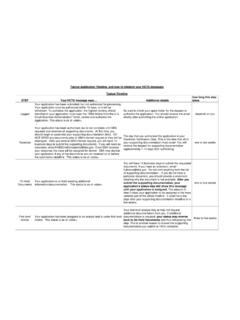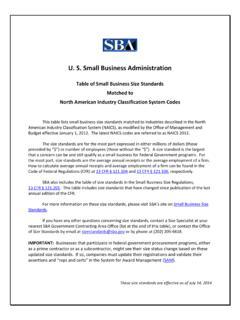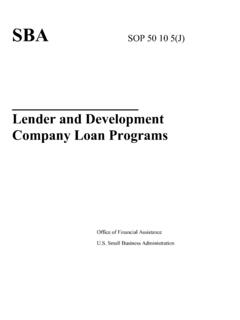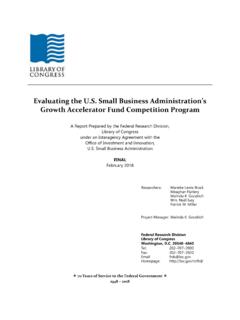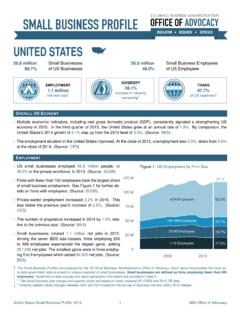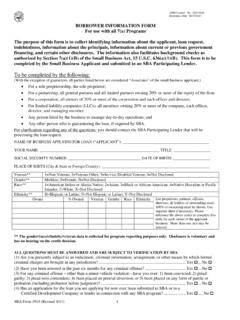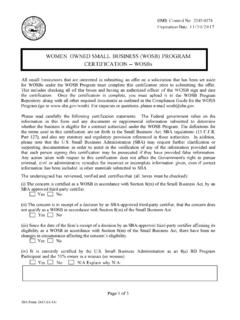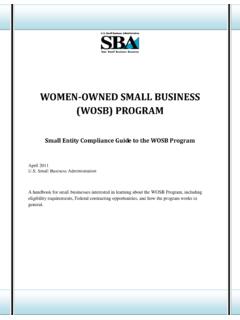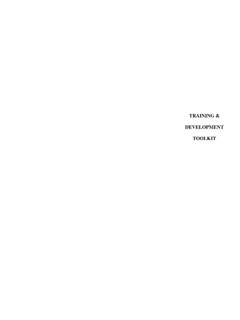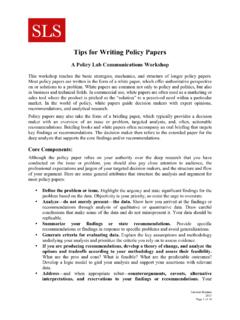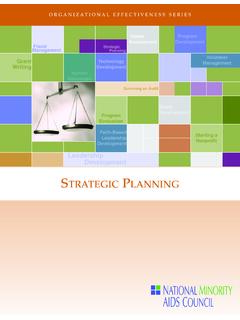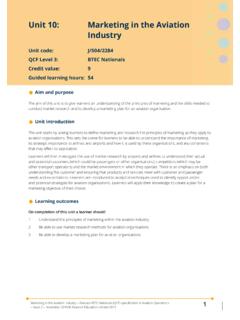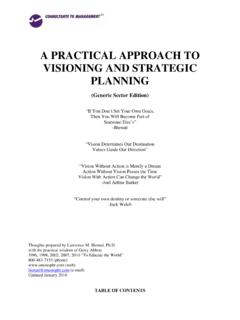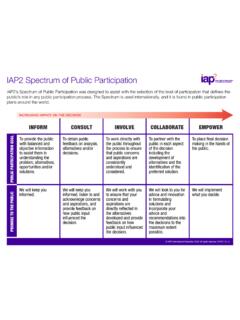Transcription of INTRODUCTION TO STRATEGIC PLANNING
1 Small Business Administration MP-21 INTRODUCTION TO STRATEGIC PLANNING Michael L. Policastro Vice President The Travelers, Hartford, Connecticut Management and PLANNING Series _____ INTRODUCTION to STRATEGIC PLANNING replaces Developing A STRATEGIC Business Plan The material in this publication may not be reproduced or transmitted in any form or by any means -- electronic, mechanical, photocopying, recording or other -- without the prior written permission of the Small Business Administration. While we consider the contents of this publication to be of general merit, its sponsorship by the Small Business Administration does not necessarily constitute an endorsement of the views and opinions of the authors or the products and services of the companies with which they are affiliated.
2 All of SBA's programs and services are extended to the public on a nondiscriminatory basis. _____ TABLE OF CONTENTS INTRODUCTION 1 WHAT IS A STRATEGIC PLAN 1 IS STRATEGIC PLANNING NECESSARY? 1 ANALYZE THE BUSINESS ENVIRONMENT 2 THE PLANNING SESSION 2 Analysis of Strengths, weaknesses , opportunities and threats (SWOTs) 2 Mission Statement 4 Key Results Areas 4 STRATEGIC Objectives 5 Tactical Objectives 5 Budgeting and the STRATEGIC Plan 6 Target Dates 6 Coordinating and Monitoring the STRATEGIC Plan 6 COMPLETING AND COMMUNICATING THE PLAN 6 WHY STRATEGIC PLANS FAIL 7 APPENDIXES A.
3 STRATEGIC PLANNING Session Agenda 9 B. STRATEGIC Plan Format 11 C. Objectives, Responsibilities and Targets C-1. Objectives, Responsibilities and Targets (Completed Sample) 15 D. Individual Objectives, Summary/Status Report 17 E. Information Resources 19 _____ INTRODUCTION This publication introduces you to STRATEGIC PLANNING . Such a plan will help you to ! Take advantage of your company's strengths. ! Eliminate or reduce your company's weaknesses . ! Capitalize on opportunities and emerging trends. ! Take defensive steps to reduce threats facing your business. ! Bring together all your company's resources, and direct them toward specific goals in areas such as sales growth, profit, productivity and service.
4 ! Prioritize and document all the goals your company wants to accomplish over the next three to five years. ! Allocate resources and assign responsibilities. _____ WHAT IS STRATEGIC PLANNING ? Ask ten people for a definition of STRATEGIC PLANNING and you will probably receive ten different answers. Most agree that it is a way to identify long-term goals and to direct your company toward fulfilling those goals. STRATEGIC PLANNING involves ! Assessing the current business environment. ! Defining your company's purpose mission. ! Deciding what you want the business to look like in three to five years.
5 ! Recognizing your company's -- Strengths -- weaknesses -- opportunities -- threats ! Mapping out a course to take the company from its current to its desired position. _____ IS STRATEGIC PLANNING NECESSARY? "My business is very small. Do I really need to develop a plan like this?" The best response to this question is, "Only if you want to stay in business and prosper.
6 " Consider the following reasons for STRATEGIC PLANNING . ! Technology and the fast pace of change are making business management more complex. STRATEGIC PLANNING will help you foresee and react quickly to market changes and opportunities and identify areas in which your business is lagging behind. ! Competition is becoming tougher. In most cases, small businesses find themselves competing with much larger companies -- ones that know the benefits of STRATEGIC PLANNING and practice it. ! From a defensive standpoint, it is important that you apply the same concepts to your operation.
7 ! Good financial control alone is not enough to ensure your business's success. In addition to a budget, you need long-term goals to determine the future direction of your company. ! You can use STRATEGIC PLANNING to involve employees in all areas of your business, so they share your goals. ! You can use your plan to communicate with bankers, who often do not understand the nature of your business. Bankers must be convinced that your company is in control of its future before they will lay their money on the line. A comprehensive plan aimed at sustained growth in sales and earnings can be very convincing.
8 ! A plan is also very helpful in dealing with your suppliers, advertisers, attorney, accountant, auditor, investors and business consultants. Let's take a closer look at the process. _____ ANALYZE THE BUSINESS ENVIRONMENT The STRATEGIC PLANNING process begins with an assessment of the current economic situation. First, examine factors outside of the company that can affect your company's performance. In most cases, it makes sense to focus on the national, local or regional, and industry economic forecasts. This part of the analysis should begin early, at least a quarter or so before you begin the formal PLANNING process.
9 Use the following common sources for information: ! The Wall Street Journal. ! The New York Times. ! Business Week. ! Industry periodicals. ! Department of Commerce (especially for the 12 leading economic indicators). ! Federal Reserve banks. ! Local industry associates. ! Local chambers of commerce. ! The public library After you have collected sufficient data, assess its present and future impact on your business. For example, slow housing starts, weak automobile sales, reduction in real disposable personal income and increasing levels of unemployment signal reduced future demand for goods and services.
10 _____ THE PLANNING SESSION After preparing a concise written assessment of the economic environment, you are ready to meet with key people in your organization for a marathon PLANNING session. Make sure that all key departments ( , sales, service, finance, processing, manufacturing, etc.) are represented to ensure that a realistic plan with a common goal is developed. The meeting will be most effective in a comfortable place that is free of interruptions and distractions. Often it is best to get away from the business premises. For many businesses the process takes two full days, so you may want to accomplish it over a weekend.
